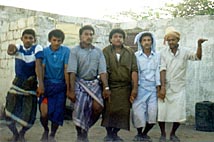
Folkloric Dance of Tihama [Archives:1999/27/Culture]
July 5 1999
# 6 in a Series:

It is important first to refer to the leading role Al-Jarahi Cultural and Literary Club has played in reviving the town’s cultural environment. It seems that Al-Jarahi’s public awareness of the country’s artistic values is perhaps far better than the official one in the area. This club (or Forum as it was named by the locals) has organized a number of cultural and artistic events and thus contributed a lot to give the necessary momentum to keep the area’s cultural heritage alive. For this purpose, the Club has founded Al-Ma’asalah, a folklore dancing team. Members in this team were chosen for their accomplishments and abilities in the Tihami Folk dance.
Al-Ma’asalah Folk Group, following a number of successful public performances in many parts of Hodeidah Governorate, has become a great attraction to the whole area’s artistic life. Its team, known for their distinguished individual talents, have shown an extraordinary mastery of all Tihami folk dances, especially a well-known Tihami dance called Al-Hakfah.
Al-Hakfah folk dance, known for having a unique taste and flavor, is performed by a group of six and sometimes more than six men dancers. The musical instruments for the performance of this dance have come out from the area’s musical traditions. They include a wind instrument called in Tihama Al-Kasabah, something similar to the flute. It is a 12 inch pipe made of plastic or sugarcane with five small holes and two openings on the top and at the bottom. The drum is also used during the performance of Al-Hakfah dance. This drum, called in Tihama Al-Marfa’a, is hollow on the inside, and made of mud and earthenware covered on top with a piece of cow’s skin tightly fastened down. The group usually performs their dance with the notes of the flute and the beats of the drums. The group begin this dance in a row (see picture), and later they move around themselves in circular motions. Suddenly, the tempo of the dancers turns into fast bodily motions as the dancers will go down and move up in a quick and stunning successive motions. The spectators, taken away with this dazzling motions, unconsciously find themselves moving with the dance. The dance is often performed during happy occasions or in special seasons of harvest, during which many players will take part in the dance to express their joy of these happy occasions.
The artistic structures of these folklore dances can only reflect the glorious civilization of the Yemeni people and its expansion back in history. The Tihami folklore dances give us some picture of the people’s great care to maintain and preserve their ancestral traditions. Therefore, it is the responsibility of the Minister of Culture to pay some attention to these important but unknown places. The folklore dancing group in Tihama should be encouraged so as to push ahead the creative energies of these groups to its maximum degree. Such groups represent essential branches to the country’s cultural and artistic movement. In this respect the Ministry of Culture and Tourism can organize special events in which these groups can participate actively to enliven folk dances and other traditional arts. It is through these means that these groups can have the opportunity to promote tourism in our country. It is important to refer here to the fact that Al-Ma’asalah folk group has taken part in many local events and national occasions within Hodeidah Governorate. Again, I would like to draw the attention of the concerned officials to the importance of such groups to the whole country’s cultural image. I hope my call will receive attentive ears in the Ministry of Culture and Tourism.
Saleh Abdulbaki,
Cultural Editor,
Yemen Times
——
[archive-e:27-v:1999-y:1999-d:1999-07-05-p:./1999/iss27/culture.htm]


